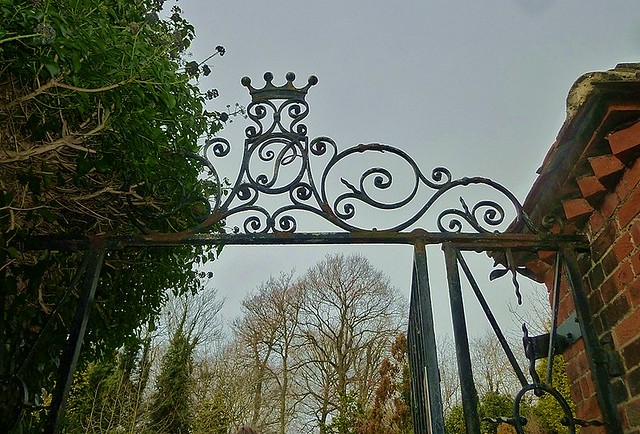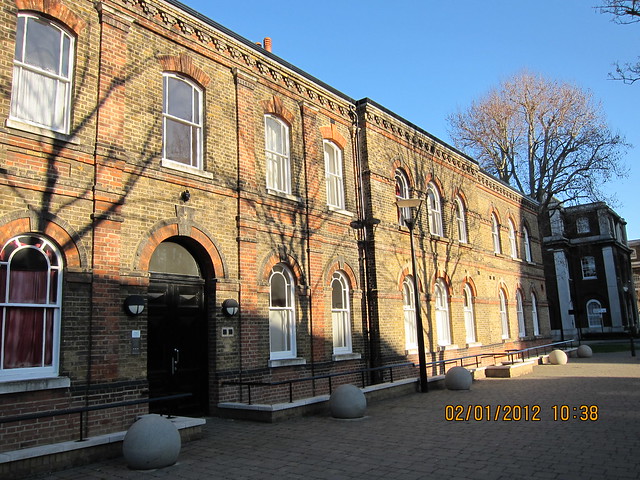
Some more good news, in my opinion, from Woolwich. The hoardings have gone up around the listed RACS building in Powis Street and work has started on its conversion into a 120 bed Travel Lodge hotel with new shops on the ground floor. The planning application includes a Heritage Statement that explains the conservation aspects of the development, and encouragingly states:
2.3 The exterior of the building is to remain largely unaffected, with exception to the ground floor shop fronts, which are non-traditional 1960’s replacements which do not contribute to the special interest of the building. In addition the principle front entrance is to undergo improvements, reinstating a traditional door in order to improve its appearance. The first and second floor windows are to be replaced with timber frames and slimlite double glazed units. The joinery details are to reflect the existing to maintain the appearance of the building. At roof top level it is proposed to install both P.V panels and plant units, both positioned to be visually unobtrusive. The majority of the external works to the front facade will be repairs, renovation and enhancements, preserving the architectural features and overall character of the building.
The Royal Arsenal Co-operative Society was set up by workers at the Royal Arsenal in 1868, based on the principles of the Rochdale Pioneers. It initially sold basic food-stuffs. However it grew rapidly and at its height had a large network of stores, and owned farms that supplied the produce it sold. As with other Co-operative organisations it was very much involved in the local community, supporting education, establishing libraries and supporting youth clubs, a cricket club, an orchestra and two choirs. Profits were distributed to the people who shopped there in proportion to how much they spent – the divi. I remember the light, tin divi tokens they used to give to shoppers, not that long ago (really).

The RACS building was completed in 1903. The statue outside, sculpted by Alfred Briscoe Drury, is of Alexander McLeod; the VADS web site describes the statue and provides a brief biography of McLeod:
Alexander Mcleod (1832-1902) one of the founders of Royal Arsenal Co-operative Society (RACS), set up by Arsenal workers in 1868. First full-time secretary from 1882 until his death.
He was the son of Skye crofters and served an apprenticeship of five years as a mechanical engineer on the Firth of Forth. He then worked for Scottish railway companies. At the age of 27 he visited a friend at the Great Eastern railway works at Stratford and secured work at the Arsenal at Woolwich where he stayed until 1878. In 1882 he was appointed dual Secretary and Manager of the Royal Arsenal Co-operative Society which had been set up by a group of workers from the Arsenal in 1868, and he remained so until his death.
McLeod was held in high regard both locally and throughout the Co-operative Movement, described in fact as ‘a Prince among secretaries’ by George Jacob Holyoake, another revered figure in the Movement. Died 17 May 1902. In his obituary in ‘Comradeship’, the RACS magazine, of June 1902, Holyoake said of him:
‘The Royal Arsenal Co-operative Society, standing like a pillar of cloud or of fire of old, to show to London the road to a better social system, is the monument that commemorates his life work’.
Alfred Drury also created the sculptures of Queen Victoria and Prince Albert at the entrance to the Victoria and Albert Museum, the statue of Joshua Reynolds in the courtyard of the Royal Academy and the Blackwall Tunnel Commemorative Plaque, as well as many others.
I’m hoping that the work on the RACS building is the start of a regeneration of the Northern end of the Woolwich shopping area. Planning approval has already been given for the redevelopment of the apex of the Woolwich triangle, with a “major retailer” lined up to occupy the largest of the new retail units there. The future of the art-deco RACS building on the opposite side of Powis Street still seems to be undecided, though there are suggestions that it won’t be demolished. There are indications that the art-deco Granada Cinema will be sensitively restored by the Christ Faith Tabernacle. Their Heritage Report has some fabulous pictures of the interior of the cinema in its prime. Then there is the middle of the odd-numbered side of Hare Street. I walk down there (fairly) often on my way to the gym at the Waterfront Leisure Centre. It seems such a shame that the proud old Victorian buildings have been given over to buddleia and broken windows. I look forward to news that they will also be restored and used again.
I think it’s great that so many of the changes to historic buildings in Woolwich and Shooters Hill have managed to strike a balance between architectural conservation and the requirements of modern use. As well as the current redevelopment of the RACS building, the Royal Arsenal development and the Royal Military College seem to have retained much of their historic architecture. And with all of the new housing being built maybe there’s hope for the regeneration of Woolwich’s retail area.




















